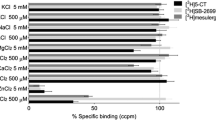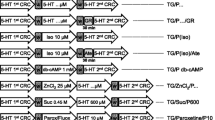Summary
The characteristics of 5-HT1A-recognition sites and receptor-mediated release of intracellular calcium were established in two transfected HeLa cell lines (HA 6 and HA 7) expressing different levels of human 5-HT1A receptors (about 3000 and 500 fmol/mg protein, Fargin et al. 1989; 1991; Raymond et al. 1989).
The pharmacological profiles of the binding (determined with [3H]8-OH-DPAT) and the calcium response (measured using Fura-2) were clearly of the 5-HT1A type. Compounds such as 5-HT, 5-CT and 8-OH-DPAT acted as full agonists on the calcium response in both HeLa cell lines. In addition, methiothepin, pindolol, NAN 190 and SDZ 216-525 (Seiler et al. 1991) acted as silent and potent antagonists.
Marked differences were observed in the responses mediated in the two cell lines. EC50 values of agonists (particularly 5-HT, 5-CT, flesinoxan and 8-OH-DPAT) were higher in HA 7 cells (up to 80-fold) than in other 5-HT1A receptor models (e.g. inhibition of adenylate cyclase in calf hippocampus). Further, a variety of compounds (ipsapirone, buspirone, spiroxatrine, MDL 73005) acted as agonists in HA 6 cells, whereas they behaved as silent antagonists in HA 7 cells (which express fewer receptors). By contrast, KB values for antagonists were comparable in HA 6 and HA 7 cells.
The present data show that EC50 values and intrinsic activity for a given drug are subject to large variations depending on the number of receptors expressed in the target tissue. The results obtained in HA 6 cells are comparable with respect to both potency and efficacy to those observed, in calf or mouse hippocampus (inhibition of forskolin stimulated adenylate cyclase), whereas the results obtained in HA 7 cells are similar to those reported in mouse cortex (which was suggested to represent an atypical subtype of the 5-HT1A receptor).
Since the agonist activity of a given compound at the same receptor can vary markedly, the present data show that intrinsic activity is not only ligand-dependent but also varies with the receptor-effector system studied. In addition, there seems to be no simple way to make predictions about intrinsic activity, since that feature is model-dependent.
Similar content being viewed by others
References
Albert PR, Zhou Q-Y, Van Tol HHM, Bunzow JR, Civelli O (1990) Cloning functional expression and messenger RNA tissue distribution of the rat 5 hydroxytryptamine-1-A receptor gene. J Biol Chem 265:5825–5832
Black JW, Leff P (1983) Operational models of pharmacological agonism. Proc R Soc Lond B 220:141–162
Black JW, Leff P, Shankley NP (1985) An operational model of pharmacological agonism: the effect of E/[A] curve shape on agonist dissociation constant. Br J Pharmacol 84:561–571
Bockaert J, Dumuis A, Bouhelal R, Sebben M, Cory RN (1987) Piperazine derivatives including the putative anxiolytic drugs, buspirone and ipsapirone, are agonists at 5-HT1A receptors negatively coupled with adenylate cyclase in hippocampal neurons. Naunyn-Schmiedeberg's Arch Pharmacol 335:588–592
Bradley PB, Engel G, Feniuk W, Fozard JR, Humphrey PPA, Middlemiss DN, Mylecharane EJ, Richardson BP, Saxena PR (1986) Proposals for the classification and nomenclature of functional receptors for 5-hydroxytryptamine. Neuropharmacology 25:563–576
Branchek TL, Weinshank RL, Macci MJ, Zgombick JM, Hartig PR (1991) Cloning and expression of a human 5-HT1D receptor. In: Fozard JR, Saxena PR (eds) Serotonin: molecular biology, receptors and functional effects. Birkhäuser, Basel, pp 21–32
Capponi AM, Lew PD, Schlegel W, Pozzan T (1989) Use of intracellular calcium and membrane potential fluorescent indicators in neuroendocrine cells. In: Conn PM (ed) Neuroendocrine peptide methodology, selected methods in enzymology. Academic Press, New York, pp 315–340
Cornfield LJ, Nelson DL, Taylor EW, Martin AR (1989) MDL 73005EF: Partial agonist at the 5-HT(1A) receptor negatively linked to adenylate cyclase. Eur J Pharmacol 173:189–192
Dumuis A, Sebben M, Bockaert J (1988) Pharmacology of 5-hydroxytryptamine-lA-receptors which inhibit cAMP production in hippocampal and cortical neurons in primary culture. Mol Pharmacol 33:178–186
Fargin A, Raymond JR, Lohse MJ, Kobilka BK, Caron MG, Lefkowitz RJ (1988) The genomic clone G-21 which resembles a β-adrenergic receptor sequence encodes the 5-HT1A receptor. Nature 335:358–360
Fargin A, Raymond JR, Regan JW, Cotecchia S, Lefkowitz RJ, Caron MG (1989) Effector coupling mechanisms of the cloned 5-HT1A receptor. J Biol Chem 264:14848–14852
Fargin A, Yamamoto K, Cotecchia S, Goldsmith PG, Spiegel AM, Lapetina EG, Caron MG, Lefkowitz RJ (1991) Dual coupling of the cloned 5-HT1A receptor to both adenylyl cyclase and phospholipase C is mediated via the same G1 protein. Cell Signalling 3:547–551
Fitzgerald L, Titeler M, Glennon RA, Yocca F (1989) Tritiated NAN-190 and tritiated BMY-7378: antagonist radioligand probes of the brain 5 HT-1A receptor. Neurosci Abstr 15:422
Gartside SE, Cowen PJ, Hjorth S (1990) Effects of MDL 73005EF on central pre and postsynaptic 5-HT1A receptor function in the rat in vivo. Eur J Pharmacol 191:391–400
Grynkiewicz G, Poenie M, Tsien RY (1985) A new generation of calcium indicators with improved fluorimetric properties. J Biol Chem 260:3440–3450
Herrick-Davis K, Titeler M (1988) Tritiated spiroxatrine a 5-HT-1A radioligand with agonist binding properties. J Neurochem 50:528–533
Hibert M, Moser P (1990) MDL-72832 and MDL-73005EF novel potent and selective 5-HT-1A receptor ligands with different pharmacological properties. Drugs Future 15:159–170
Hjorth, S, Sharp T (1990) Mixed agonist-antagonist properties of NAN-190 at 5-HT-1A receptors: behavioural and in-vivo brain microdialysis studies. Life Sci 46:955–963
Hoyer D (1989) Biochemical mechanisms of 5-HT receptor-effector coupling in peripheral tissues. In: Fozard JR (ed) The peripheral actions of 5-hydroxytryptamine. Oxford University Press, Oxford, pp 72–99
Hoyer D, Engel G, Kalkman HO (1985) Molecular pharmacology of 5-HT1 and 5-HT2 recognition sites in rat and pig brain membranes: radioligand binding studies with [3H]5-HT, [3H]8-OH-DPAT, (−)[125I]iodocyanopindolol, [3H]mesulgerine and [3H]ketanserin. Eur J Pharmacol 118:13–23
Hoyer D, Neijt HC (1988) Identification of serotonin 5-HT3 recognition sites in membranes of N1E-115 neuroblastoma cells by radioligand binding. Mol Pharmacol 33:303–309
Julius D, MacDermott AB, Axel R, Jessel TM (1988) Molecular characterization of a functional cDNA encoding the serotonin 1c receptor. Science 241:558–564
Kenakin TP, Morgan PH (1989) Theoretical effects of single and multiple transducer receptor coupling proteins on estimates of the relative potency of agonists. Mol Pharmacol 35: 214–222
Kobilka BK, Frielle T, Collins S, Yang-Feng T, Kobilka TS, Francke U, Leftkowitz RJ, Caron CG (1987) An intronless gene encoding a potential member of the family of receptors coupled to guanine nucleotide regulatory proteins. Nature 329:75–77
Meller E, Goldstein M, Bohmaker K (1990) Receptor reserve for 5 hydroxytryptamine-1A-mediated inhibition of serotonin synthesis: possible relationship to anxiolytic properties of 5 hydroxytryptamine-1A agonists. Mol Pharmacol 37:231–237
Middleton JP, Raymond JR, Whorton AR, Dennis VW (1990) Short-term regulation of Na+/K+ adenosine triphosphatase by recombinant serotonin 5-HT1A receptor expressed in HeLa cells. J Clin Invest 86:1799–1805
Moser PC, Tricklebank MD, Middlemiss DN, Mir AK, Hibert MF, Fozard JR (1990) Characterization of MDL-73005EF as a 5-HT-1A selective ligand and its effects in animal models of anxiety comparison with buspirone, 8-hydroxy-DPAT and diazepam. Br J Pharmacol 99:343–349
Nelson DL, Monroe PJ, Yamamura HI (1987) [3H]spiroxatrine labels a serotonin-like site in the rat hippocampus. Life Sci 41: 1567–1576
Peroutka SJ (1988) 5-Hydroxytryptamine receptor subtypes. Ann Rev Neurosci 11:45–60
Pritchett DB, Bach AWJ, Wozny M, Taleb O, Dal Toso R, Shih JC, Seeburg PH (1988) Structure and functional expression of cloned rat serotonin 5-HT2 receptor. EMBO J 7:4135–4140
Przegalinski E, Ismaiel AM, Chojnacka-Wojcik E, Budziszewska B, Tatarcynska D, Blaszcynska E (1990) The behavioural, but not the hypothermic or corticosterone, response to 8-hydroxy-2-(din-propylamino)-tetralin, is antagonized by NAN-190 in the rat. Neuropharmacol 29:521–526
Raymond JR (1991) Protein kinase C induces phosphorylation and desensitization of the human 5-HT1A receptor. J Biol Chem 266:14747–14753
Raymond JR, Fargin A, Middleton JP, Graff JM, McNeill Haupt D, Caron MG, Lefkowitz RJ, Dennis VW (1989) The human 5-HT(1A) receptor expressed in HeLa cells stimulates sodium-dependent phosphate uptake via protein kinase C. J Biol Chem 264:21943–21950
Raymond JR, Albers FJ, Middleton JP, Lefkowitz RJ, Caron MG, Obeid LM, Dennis VW (1991) 5-HT1A and histamine H1 receptors in HeLa cells stimulate phosphoinositide hydrolysis and phosphate uptake via distinct G protein pools. J Biol Chem 266:372–378
Rydelek-Fitzgerald L, Teitler M, Fletcher PW, Ismaiel AM, Glennon RA (1990) NAN-190: agonist and antagonist interactions with brain 5-HT1A receptors. Brain Res 532: 191–196
Schoeffter P, Hoyer D (1988) Centrally acting hypotensive agents with affinity for 5-HT1A binding sites inhibit forskolin-stimulated adenylate cyclase activity in calf hippocampus. Br J Pharmacol 95:975–985
Schoeffter P, Hoyer D (1989a) Interactions of arylpiperazines with 5-HT1A, 5-HT1B, 5-HT1C and 5-HT1D receptors: do discriminatory 5-HT1B ligands exist? Naunyn-Schmiedeberg's Arch Pharmacol 339:675–683
Schoeffter P, Hoyer D (1989b) How selective is GR 43175? Interactions with functional 5-HT1A, 5-HT1B, 5-HT1C and 5-HT1D receptors. Naunyn-Schmiedeberg's Arch Pharmacol 340:135–138
Seiler MP, Stoll A, Hagenbach A, Floersheim P, Fozard JR, Kalkman HO, Mir AK, Siegl H, Schoeffter P, Hoyer D (1992) Novel approaches to drugs acting on “5-HT1 like” receptors. In: Sarel S, Mechoulam R, Agranat I (eds) Trends in medicinal chemistry “90”. Blackwell Scientific Publications (in press)
Sharp T, Backus LI, Hjorth S, Bramwell SR, Grahame-Smith DG (1990) Further investigation of the in vivo pharmacological properties of the putative 5-HT1A antagonist, BMY 7378. Eur J Pharmacol 176:331–340
Yocca FD (1990) Neurochemistry and neurophysiology of buspirone and gepirone: Interactions at presynaptic and postsynaptic 5-HT1A receptors. J Clin Psychopharmacol 10:6S–12S
Yocca FD, Hyslop DK, Smith DW, Maayani S (1987) BMY 7378, a buspirone analog with high affinity selectivity and low intrinsic activity at the 5-HT1A receptor in rat and guinea-pig hippocampal membranes. Eur J Pharmacol 137:293–294
Zemlan FP, Zieleniewski-Murphy A, Murphy RM, Behbehani MM (1990) BMY-7378 partial agonist at spinal cord 5-HT-1A receptors. Neurochem Int 16:515–522
Author information
Authors and Affiliations
Additional information
Send offprint requests to D. Hoyer at the above address
J. R. Raymond was supported by the American Heart Association (Grant in Aid) and by a V. A. Merit Award
Rights and permissions
About this article
Cite this article
Boddeke, H.W.G.M., Fargin, A., Raymonde, J.R. et al. Agonist/antagonist interactions with cloned human 5-HT1A receptors: variations in intrinsic activity studied in transfected HeLa cells. Naunyn-Schmiedeberg's Arch Pharmacol 345, 257–263 (1992). https://doi.org/10.1007/BF00168684
Received:
Accepted:
Issue Date:
DOI: https://doi.org/10.1007/BF00168684




